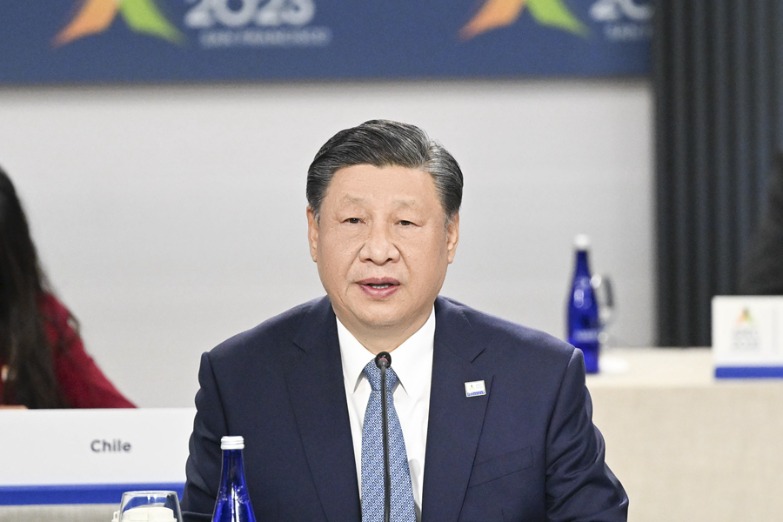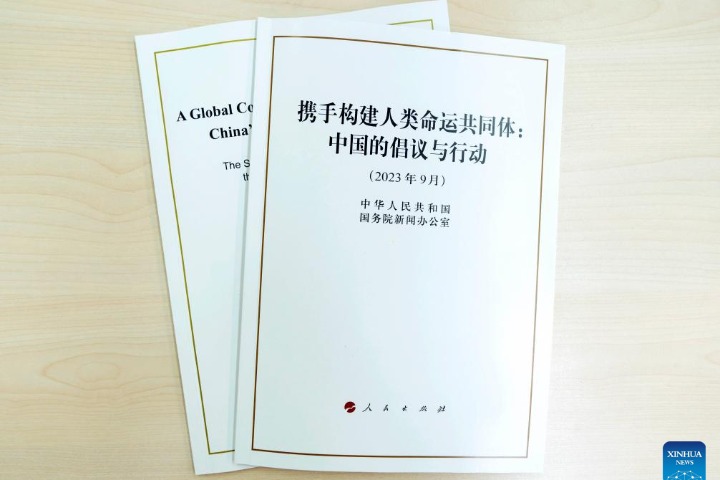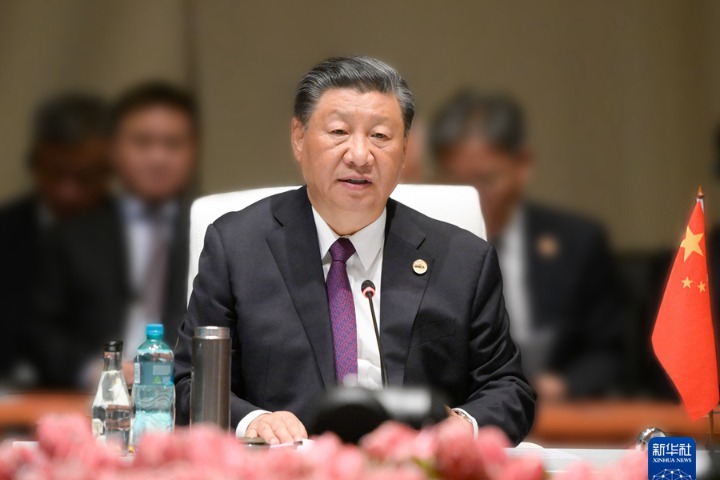西藏和平解放与繁荣发展(双语全文)
新华网 2021-05-21 16:00

五、脱贫攻坚全面胜利
V. A Complete Victory over Poverty
西藏是全国贫困发生率最高、贫困程度最深、扶贫成本最高、脱贫难度最大的集中连片特困地区。消除贫困是中央人民政府的一贯政策,早在西藏和平解放初期,进藏人民解放军及工作人员就做了许多扶贫济困的工作。废除封建农奴制度后,西藏走上了社会主义道路,中国共产党以解放生产力,发展生产力,消灭剥削,消除贫困,实现共同富裕为己任,一代一代人致力于发展经济、改善民生工作。中国共产党第十八次全国代表大会以来,连续5年召开深化对口援藏扶贫工作会议,创新开展“央企助力富民兴藏”等活动,通过精准施策、精准帮扶,西藏打赢脱贫攻坚战,各族人民实现了不愁吃、不愁穿和义务教育、基本医疗、住房安全有保障。截至2019年底,全区62.8万建档立卡贫困人口已全部脱贫,74个贫困县区全部摘帽,历史性消除了绝对贫困问题,目前已脱贫人口年人均可支配收入突破1万元,脱贫成果得到进一步巩固。事实说明,民主改革使西藏社会制度一步跨千年,脱贫攻坚让西藏人民生活方式一步跨千年。
Tibet was a contiguous poor area with the highest incidence and most severe level of poverty, where the cost of poverty eradication was highest and the difficulty greatest. Ending poverty in Tibet is a consistent policy of the Central People's Government.
As early as 1951, after the liberation of Tibet, the PLA and other organizations in Tibet were already taking action to reduce poverty.
In 1959 after feudal serfdom was abolished and Tibet embarked on the path of socialism, the CPC set about developing the productive forces, eliminating exploitation and poverty, achieving common prosperity, growing the economy, and improving people's lives.
After the 18th CPC National Congress in 2012, the Party convened the National Conference on Better Poverty Alleviation Partnership Assistance from Other Parts of the Country to Tibet for five successive years, and launched a campaign under which SOEs directly under the central government would assist Tibet in achieving prosperity. Through targeted poverty alleviation policies and measures, Tibet has won a decisive victory over poverty, and local people of all ethnic groups now have adequate food and clothing and access to compulsory education, basic medical services and safe housing.
By the end of 2019, all the 628,000 registered poor and 74 designated poor counties in Tibet had risen from poverty, marking the end of absolute poverty in Tibet for the first time in history. The average annual per capita disposable income of those who have just emerged from poverty now exceeds RMB10,000, an indication that the positive results of poverty elimination have been consolidated.
It was the democratic reform in Tibet that led to leapfrog progress in its social system, and the fight against poverty secured historic improvements in its ways of life.
——绝对贫困彻底消除
– Eliminating absolute poverty
发展特色产业,找准发展路子。大力发展青稞和牦牛产业,推广“藏青2000”“喜玛拉22”“帕里牦牛”“类乌齐牦牛”“岗巴羊”等优良品种,提高单产水平。扶持深加工,创新产品供给,扩展产业链。2020年,西藏共有农牧业产业化龙头企业162家,农畜产品加工业总产值57亿元,比2015年末翻了一番。通过“合作社+农户”“龙头企业+村集体经济组织+农户”等方式,不断提高专业化水平和生产效率,主要农作物综合机械化率达到65%。推进电商扶贫,量身打造电子商务进农村整区推进模式,累计安排中央财政资金8.79亿元,带动特色农产品网上销售,促进农牧民增收就业,助力脱贫攻坚。重点发展旅游业,创新升级“藏文化体验游”,打造“最美318线”,推出“冬游西藏”等。截至2020年,西藏农牧民通过直接或间接方式参与乡村旅游就业8.6万人(次),年人均增收4300余元。发展文化产业,扶持传统文化的市场化开发,唐卡、塑像及传统手工技艺如纺织、服饰、家居装饰等供需两旺,已形成颇具规模的新兴产业。建成各级各类文化产业示范园区(基地),产值超过60亿元,年均增长率15%。2016年以来,西藏累计整合涉农资金753.8亿元用于脱贫攻坚,实施产业扶贫项目3037个,直接带动23.8万建档立卡贫困群众脱贫,发放贴息贷款647.68亿元、小额信贷63.32亿元,为产业发展提供强大支撑。
Tibet has made great efforts to develop industries that leverage local strengths, to find the right path for economic growth. It has been vigorously developing and promoting highland barley strains such as Zangqing 2000, Ximala 22, and livestock breeds such as Pagri yak, Riwoqe yak, and Gamba sheep, to raise the per unit yield.
Tibet has been supporting deep processing, improving product supply, and expanding industrial chains. In 2020, there were 162 leading agriculture and animal husbandry enterprises, with a total processing output value of RMB5.7 billion. This was double the figure for 2015.
Tibet has been increasing the level of specialization in production and boosting production efficiency through cooperation between cooperatives and rural households, and among leading enterprises, village-level collective economic organizations and rural households. The comprehensive mechanization rate for growing staple crops has reached 65 percent.
Tibet has been alleviating poverty by developing e-commerce programs targeted at the entire rural community to improve the marketing of local specialties. A total of RMB879 million from the state budget was allocated to promote the online sales of agro-products, boost incomes and employment, and reduce poverty in Tibet.
Tibet has been fully engaged in developing tourism, launching programs such as “Tibetan Cultural Tour”, “G318 Self-drive Tour” for the 2018 Around China Self-driving Tour Championship (ACSC), and “Winter Tour in Tibet”. By 2020, rural tourism had created, directly or indirectly, 86,000 jobs for local farmers and herdsmen, resulting in an increment in annual per capita income of RMB4,300.
Tibet has been developing its cultural industry by expanding the market for traditional Tibetan culture. Thangka, sculpting, textiles, costumes, home decoration and other handicrafts have grown into emerging industries, huge in both supply and demand. Cultural industry demonstration parks/centers at all levels and in all categories have been completed, creating a total output value of more than RMB6 billion at an average annual growth rate of 15 percent. Since 2016, Tibet has applied agricultural funds totaling RMB75.4 billion to poverty alleviation and implemented 3,037 programs supporting local businesses, which has helped 238,000 registered poor out of poverty. It has issued subsidized loans of RMB64.8 billion and micro-credit loans of RMB6.33 billion, providing strong support for the development of local industries.
实施农村危房改造,实现住房安全有保障。2008年以来,累计下达资金36.18亿元,支持西藏建档立卡贫困户、农村低保户、分散供养特困人员、贫困残疾人家庭等4类重点对象39.97万户,通过实施农村危房改造,告别了破旧的夯土房、石砌房等危房,住上了宽敞明亮的安全房。对于部分鳏寡孤独等无力改造住房的特困群众,通过统建农村集体公租房、修缮加固现有闲置公房等方式,兜底解决其住房安全问题,为打赢脱贫攻坚战和全面建成小康社会奠定了坚实基础。
Efforts have been made to renovate dilapidated rural homes to ensure safe housing. Since 2008, a total of RMB3.62 billion has been applied to 399,700 households in Tibet for the renovation of dilapidated homes, covering registered poor households, households entitled to subsistence allowances, severely impoverished rural residents cared for at their homes with government support, and impoverished families of individuals with disabilities. The project has enabled them to abandon rammed-earth dwellings and stone shacks, and presented them with bright and spacious housing. The widowed, orphaned and childless in extreme poverty are eligible for rural public rental housing, or vacant public housing that has been renovated, to guarantee their access to safe housing. All these measures have laid a solid foundation for Tibet to beat poverty and achieve moderate prosperity.
实施易地搬迁,改善生产生活条件。西藏的贫困人口主要集中在藏北高海拔牧区、南部边境地区和藏东横断山区等海拔高条件差、远离腹心市场的地区,易地搬迁成为摆脱贫困的合理选择。2016年以来,西藏加大了以扶贫脱贫为目标的易地搬迁力度,截至2020年,在海拔较低、适宜生产生活的地区建成了964个易地扶贫搬迁区(点),26.6万人自愿搬迁。全区产业扶贫资金的5%用于安置点产业发展,确保每个搬迁户至少“一户一人”就业,实现了稳得住、有就业,逐步能致富。
Tibet has relocated the impoverished to improve their living and working conditions. Poverty-stricken populations in Tibet are concentrated in the northern pastoral areas, the southern border areas, and the eastern areas along the Hengduan Mountains. All these areas are located at high altitudes. They are remote from vital markets and live in harsh conditions. Therefore, relocating the inhabitants of these areas is a rational solution to lift them out of poverty. Since 2016, Tibet has increased efforts to resettle the impoverished from inhospitable areas to places with better economic prospects. By 2020, Tibet had completed the construction of 964 relocation zones/sites for poverty alleviation in low-altitude, hospitable areas, where 266,000 poor were happy to resettle. Some five percent of Tibet's growth-driven poverty alleviation funds were applied to the development of industries and businesses at relocation sites, and at least one individual from each resettled household was guaranteed employment. This was a significant primary step ensuring steady progress toward a prosperous life.
坚持扶贫先扶志扶智,培育内生动力。坚持教育经费向贫困地区、基础教育、职业教育倾斜政策,帮助贫困地区改善办学条件。西藏已全面建成从学前教育到高等教育阶段的学生资助体系,资助政策达40项,资助范围实现各学段全覆盖、公办民办全覆盖、家庭经济困难学生全覆盖。目前,教育“三包”经费标准提高到年生均4200元,建档立卡贫困家庭失辍学生动态清零。推动高校面向农牧区和贫困地区学生专项招生。落实“三免一补”政策,“十三五”期间累计资助在校贫困大学生4.67万人次。结合市场需求和贫困群众意愿,开展建筑、生活服务、食品加工、汽车维修、护理、手工艺等职业技术教育,为贫困人口提供相对稳定和报酬更高的就业机会。
Tibet has implemented policies to sustain poverty elimination through the endogenous initiatives of the poor themselves by increasing their confidence and helping them acquire knowledge and skills. Tibet's education funds are directed more to basic education and vocational education in poor areas to improve conditions there. Tibet has established a student financial assistance system covering all stages of education from preschool to higher education, covering both private and public education, and covering all students experiencing economic difficulties, supported by 40 financial assistance policies. The Three Guarantees policy for education in Tibet – providing food, accommodation and school expenses for preschool to senior high students from farming and herding households and impoverished urban families – has resulted in a rise in subsidy to an average of RMB4,200 per student per year; dropouts from registered poor families are all identified and helped back into school in a timely manner.
Tibet has encouraged institutions of higher learning to recruit students from its farming and pastoral areas and poverty-stricken areas through special programs. Tibet has implemented the Three Cost-frees and One Subsidy policy, under which college students from registered poor households and rural families entitled to subsistence allowances are exempt from tuition, textbook and accommodation fees and are provided with cost-of-living subsidies. Altogether 46,700 impoverished undergraduates received assistance from this policy during the 13th Five-Year Plan period (2016-2020). Based on market demand and personal choice, poor populations in Tibet are provided with vocational and technical education covering constructional engineering, service, food processing, vehicle repair and maintenance, nursing, and handicrafts, to help them obtain stable jobs with higher payments.
提高社会保障水平,实现兜底保障。西藏对11.4万建档立卡贫困人口实施社会救助兜底保障,实现应保尽保,城乡居民最低生活保障标准分别提高至每人每年10164元和4713元,农村分散供养和城乡集中供养的特困人员基本生活标准分别提高至每人每年7070元、13213元;临时救助平均水平提高至4334元/人次。在74个国家级贫困县实施贫困地区儿童营养改善项目,改善6至24月龄儿童营养状况。
Tibet has improved social security by providing subsistence allowances for the impoverished. All the 114,000 registered poor in Tibet are provided with subsistence allowances. Currently, the standards are RMB10,164 per person per year for urban residents, RMB4,713 for rural residents, RMB7,070 for severely impoverished rural residents cared for at their homes with government support, and RMB13,213 for severely impoverished urban and rural residents cared for at nursing homes with government support. The standard for temporary social relief has been raised to RMB4,334 on average. In all its 74 national-level poor counties, Tibet has implemented the national nutrition improvement program for children in impoverished areas, targeted at 6 to 24-month-olds.
实施“强基惠民”工程,创新结对帮扶措施。2012年至2020年,连续9批选派干部19.33万余人次开展驻村帮扶。各级干部与所有贫困县、乡、村、建档立卡户结对帮扶,为贫困地区产业发展和贫困户转移就业、贫困家庭大学生就业等提供一对一帮助。
Tibet has implemented the project of “Laying the Foundations for Better Lives”, through innovative paired-up assistance for the impoverished. From 2012 to 2020, Tibet dispatched 193,300 resident officials in nine groups to help alleviate poverty in villages. Officials at all levels in Tibet were paired up with registered poor households in all designated poor villages, townships and counties, to offer one-to-one employment assistance to the relocated poor and college graduates from impoverished families, and to help boost the economy in poverty-stricken areas.
——兴边富民大力推进
– Developing border areas and improving people's lives
西藏边境线长达4000多公里,多数地方生产生活条件十分恶劣,贫困发生率高,兴边富民一直为各级政府所重视。在党中央的关怀下,边境地区投入逐年增加。特别是2012年以来,边境县、乡、村充分享受到国家更加优惠的政策,水、电、路、居等人民生活急需的基础设施加大了建设力度。2017年西藏发布《西藏自治区边境地区小康村建设规划(2017-2020年)》,主要目标是改善边民的住房条件和边境村庄的“水电路讯网、教科文卫保”以及产业建设。截至2020年底,边境一、二线行政村公路通达通畅,主电网延伸到全部边境乡(镇),实现村村通邮,移动通信网络全覆盖,农村人口饮水安全得到保障。边境村庄基础设施条件显著改善,各类产业蓬勃发展,边民生产生活水平明显提升。
Tibet has a 4,000-km long external border line. The inhabitants of the contiguous areas experience harsh living and working conditions and a high incidence of poverty. Governments at all levels have been making constant efforts to develop border areas and improve people's lives. Under the guidance of the Party Central Committee, financial input has been increasing year by year for border development in Tibet. Particularly since 2012, border villages, townships and counties in Tibet have been granted more preferential state policies on infrastructure construction, covering water, electricity, roads, and housing. In 2017, the Plan of Tibet Autonomous Region on the Construction of Villages of Moderate Prosperity in Border Areas (2017-2020) was released, designed to ensure better access to housing, water, electricity, roads, communications and the internet, to improve education, technology, culture, healthcare and social security in border villages, and to boost industries in border areas. By the end of 2020, first-tier and second-tier border villages had access to highways, all border townships and towns were connected to the main power grid, and all border villages had access to postal services, mobile communications, and safe drinking water. Through all these efforts in the border areas in Tibet, infrastructure has seen remarkable improvements, all industries are flourishing, and the people enjoy better living and working conditions.
——乡村振兴有序实施
– Revitalizing the countryside
2017年,中国提出乡村振兴战略。根据党中央部署,西藏编制《西藏自治区乡村振兴战略规划(2018-2022年)》,按照产业兴旺、生态宜居、乡风文明、治理有效、生活富裕的总要求,巩固拓展脱贫攻坚成果,同乡村振兴有效衔接。着力发展高原生物、旅游文化、绿色工业、清洁能源、现代服务、高新数字、边贸物流等产业。着力创新农牧区人才培养方式,规模化培训乡土人才,建立完善农牧民教育培训体系,统筹各类人才向乡村聚集。着力推广新型村规民约,提升公共文化服务水平,繁荣农业农村农民题材文艺创作,传承发展优秀传统文化,加强乡村文化队伍建设等,培育文明乡风、良好家风、淳朴民风。着力通过生态系统保护与修复、人居环境整治、生态产业发展、乡村生态文明体制机制建设,确保生态环境质量保持全国领先水平,把西藏农牧区建设成为生态宜居、环境优美、人与自然和谐共生的美丽乡村。
In 2017, China proposed the strategy of rural revitalization. Accordingly, the Strategic Plan of Tibet Autonomous Region on Rural Revitalization (2018-2022) was formulated, to build rural areas with thriving businesses, an eco-friendly environment, social etiquette and civility, effective governance, and a prosperous rural population, making sure that the positive results in poverty elimination are consolidated and become an integral part of rural revitalization in Tibet. The plan focuses on:
• developing plateau biotechnology, tourism, green industry, clean energy, modern services, advanced digital technology, and border trade and logistics;
• improving talent training in farming and pastoral areas, scaling up the training of native professionals, establishing a complete training system for farmers and herdsmen, and attracting talent toward rural development;
• promoting civilized village rules, improving public cultural services, encouraging literary and artistic works on agriculture, rural areas and rural people, carrying forward the best of traditional Tibetan culture, strengthening the competence of rural cultural workers, nurturing healthy folk customs, cultivating fine family traditions, and encouraging virtues in individuals;
• protecting and restoring the rural eco-system, improving rural living environments, developing eco-friendly rural industries, and building institutional mechanisms for promoting rural eco-environmental progress, so as to keep Tibet's eco-environment at the highest national level, and turn its farming and pastoral areas into a beautiful, hospitable countryside where the people live in harmony with nature.

















 英语点津微信
英语点津微信 双语小程序
双语小程序